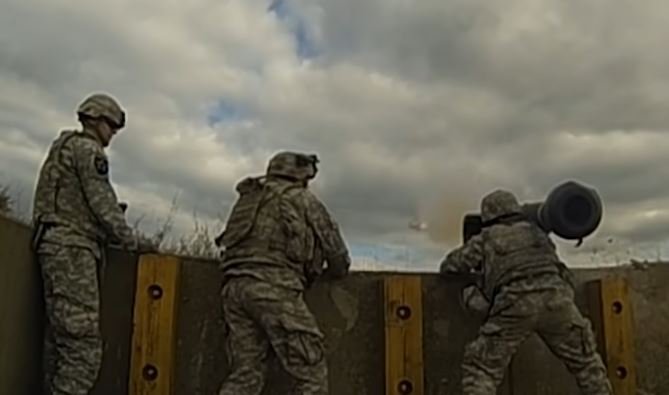Has Our Government Learned Its Lesson From The Afghan Withdrawal?
For many Americans and veterans, images of the Taliban sporting American military gear around American military equipment are still fresh in our minds. However, with the war in Ukraine lasting longer than ‘military experts’ claimed and increasing demand to send more assistance, one has to ask if our government has learned its lesson from the Afghan withdrawal. Have we put measures in place to make sure American weaponry and equipment don’t fall into the wrong hands? They have not.
The US has few ways to track the weapons it has sent to Ukraine, sources tell CNN, a blind spot that’s due in large part to the lack of US boots on the ground in the country https://t.co/ugDS4jTyUe
— CNN (@CNN) April 19, 2022
Earlier this week, CNN reported that the U.S. doesn’t have a great idea of what happens to the weapons and equipment funneling into Ukraine. Specifically of concern are the Javelins and Switchblades.
The Javelin Weapon System is a shoulder-fired anti-armor system. The Switchblade 300 is a lightweight drone armed with a small explosive warhead. While Javelins do have serial numbers, there isn’t a great way to track the transfer of this equipment once it gets in theater and out of American hands. Alarmingly a senior defense official told CNN, “We may never know exactly to what degree they’re using the Switchblades.”
Pentagon Press Secretary John Kirby also stated that the DOD doesn’t earmark the weapons it sends for particular units.
RELATED: Video: Jim Jordan Says It Would Be Nice If Weapons We Left In Afghanistan Were Instead In Ukraine
Nothing New
It’s not that we are sending aid and equipment to Ukraine that causes me consternation. Instead, it’s the fact that we haven’t figured out a way to track this equipment.
Jordan Cohen, a Defense and Foreign Policy Analyst at the CATO Institute who focuses on arms sales, said the danger surrounding the flood of weapons funneled into Ukraine is what happens to them when the war ends.
Support Conservative Voices!
Sign up to receive the latest political news, insight, and commentary delivered directly to your inbox.
This isn’t a new worry, nor is the concept of American weapons and equipment getting lost in the fog of war.
For example, weapons sold to Saudi Arabia and the United Arab Emirates found their way to al-Qaeda and Iran.
And for those unfamiliar with former Representative Charlie Wilson and the movie aptly named Charlie Wilson’s War, we have sent arms into Afghanistan for decades, first to arm the mujahideen in their fight against the Soviet army, then to arm Afghan forces in their fight against the Taliban. But unfortunately, some of those weapons ended up on the black market in both instances.
The Afghan Debacle
Roughly $88 billion was allocated to equip the Afghan National Defense and Security Forces (ANDSF). However, with the rushed nature of our withdrawal, we saw that the very group we ousted at the beginning of the conflict was back in power and more powerful than ever and better-equipped military, thanks mainly to what we left behind.
Assault rifles, pistols, machine guns, missiles, aircraft, helicopters, and armored vehicles were some of what we left behind.
While the argument is that most of this equipment was destroyed beyond the ability to use, there is something more to having American military equipment than just its utility.
Having these items act as valuable propaganda props and income-generating activities.
Weapons that the United States left to the Afghan army pic.twitter.com/xIw2iW2Uim
— Anton Gerashchenko (@Gerashchenko_en) March 29, 2022
Displaying the capture of this weaponry to the world was a way of reinforcing the Taliban narrative of the defeat of the U.S. and Afghan National Forces.
This underscores the Taliban messaging that they are the true allies of the Afghan people and the only ones able to protect them.
This could push Central Asian countries like Tajikistan or Uzbekistan to strengthen bilateral security ties with both Moscow and Beijing. Or worse, to be more open to dealing diplomatically with the Taliban.
Even if the argument that these weapons are destroyed and only able to be utilized as props, which honestly is a big deal, we left behind more than just weaponry.
From just one base, the Taliban are known to have acquired over 160,000 radios and pieces of communications equipment and 16,000-night-vision goggles. There is more to fighting wars and inflicting pain on others than ammunition and missiles. These other non-lethal forms of military gear can be game-changers within the theater of operations.
RELATED: Trump Has An Idea For The Billions In Weapons Biden Left For The Taliban
Where We Are Today
According to Mark F. Cancian of the Center for Strategic and International Studies, we supplied close to a third of our supply of Javelin missiles. While that might seem fine with two-thirds in stock, the reality is that war planners like to maintain a certain inventory level if a conflict breaks out with North Korea or other adversaries.
President Biden announced today that he is approving another $800 million in aid to Ukraine. He stated we had supplied close to $1 billion in the last two months; rough calculations should put us over $3 billion to Ukraine in total aid.
President Biden says the U.S. will give another $1.3 billion in military and humanitarian aid to Ukraine, but that additional funding will soon be needed from Congress to continue the flow of weapons. https://t.co/kXEbXs5jWa
— NBC Politics (@NBCPolitics) April 21, 2022
With inflation the main issue plaguing American voters and our terrible track record of making sure our weapons don’t wind up in the wrong hands, it is only natural that Americans should be concerned.
It’s hard not to want to send as much aid and assistance as we can to the brave Ukrainian people as they fight off a monster.
However, I don’t think it’s too much to ask that our government to figure out how to track what gets sent over and to where.
In a world where I can follow a purchase in real-time from the warehouse to my house, I find it odd we can’t track equipment that has serial numbers attached to them.






